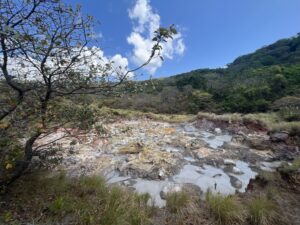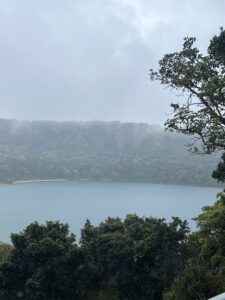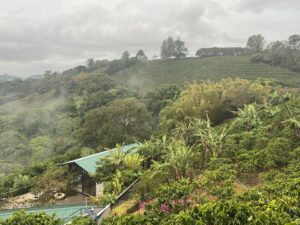Take a moment to imagine; the sun is radiating an unrelenting heat, a rosy hue streaks the sky, sweat trickles down your neck, and you get hints of rotten eggs wafting your way. This was the exact situation I was in this spring at Rincon de la Vieja National Park in Costa Rica. In fact, that rancid smell is actually caused by hydrogen sulfide released from an iconic characteristic of tropical dry forests: mud pots. These “Las Pailas” (another name for boiling mud pots) are basically natural boilers. Surface water gets collected, and thermal water below it releases steam to heat this water on top. Tropical dry forests (TDFs) can contain these mud pots and are identified by a long dry season with little rainfall. Concerningly, TDFs used to account for over 40% of all tropical forests, however, they are now significantly threatened by agricultural practices and the ever-looming impact of climate change.

Figure 1: A boiling mud pot at Rincon de la Vieja
Rincon de la Vieja National Park hosts over 300 species of birds and a variety of mammals, such as the two-toed sloth, kinkajous, and monkeys, and is one of the limited homes for TDFs. The park’s name translates to “the old woman’s corner.” The indigenous people from the Guatuso tribe named it after the volcano there, which would emit smoke periodically and had intense sessions of activity. Before visiting Costa Rica, I was expecting our hikes to be moist and rainy; we were hiking in a rainforest. While we did have many instances where we were soaked throughout the hike, especially in places like Poas (a volcano) and the San Carlos waterfalls, Rincon was the complete opposite. It is fascinating to see how diverse the climates can be across Costa Rica, and through many hikes, I have come to an unexpected appreciation for this diversity.

Figure 2: A picture of a dormant crater near Poas Volcano
In particular, TDFs have many unique wildlife that have evolved to thrive in this different environment. For instance, deciduous trees like mountain ebony and teak shed their leaves to save water in the dry season. Some species of insects here actually burrow into the ground and lay dormant until rain returns, and the biome is home to a population of iguanas.

Figure 3: A Spiny-Tailed Iguana (Genus Ctenosaura)
TDFs are also an attractive area for farmers as the soil is fertile enough to grow to produce, and the dry season suppresses weeds, vegetation regeneration, and pests. With the Costa Rican economy being mainly dependent on agriculture and tourism, this raises a troublesome issue. TDFs contain unique traits that need to be preserved with the ever-expansion of agriculture. In fact, coffee farming can pose a huge risk to this endangered biome due to the international demand for fine gourmet coffee beans that the country is known for. In regards to that industry, my trip to the Hacienda Alsacia Starbucks Coffee Farm simply proved to me how taxing the farming of coffee beans can be to the surrounding landscape and how it can destroy the diversity of the region that originally existed there. I also learned of the various steps taken to combat this damage.

Figure 4: An image of the vast farmland at Hacienda Alsacia Starbucks Cofee Farm
After visiting all of these locations in Costa Rica and gaining a deeper understanding of the situation across the country, from Alajuela to San Jose, I have realized that we need to create awareness for TDFs. As it stands right now, in a paper by the Center for International Forestry Research, TDFs are rarely protected and are considered less valuable in carbon trade schemes. Moreover, most conservation programs do not consider TDFs separate forests despite the wild climate and species interaction differences. Immersing myself in the nature and culture of Costa Rica this spring allowed me to realize the majestic beauty that resides if you take the time to look closely. I wish all readers to take a step back from the hustle and bustle of their daily routine and try to make a difference for these endangered TDF biomes; little by little, step by step, true change can happen if we give it a chance.
Sources:
The Case for conserving tropical dry forests | Yale Environment Review
Volcán Rincón de la Vieja National Park (costa-rica-guide.com)
Costa Rica Climate – Learn about the weather in Costa Rica
Why The Dry Tropical Forest In Rincon De La Vieja Is Unique | Hacienda Guachipelin
Photo references:
Figure 1: Photo taken by Ishaan Patil
Figure 2: Photo taken by Ishaan Patil
Figure 3: Photo taken by Ishaan Patil
Figure 4: Photo taken by Ishaan Patil